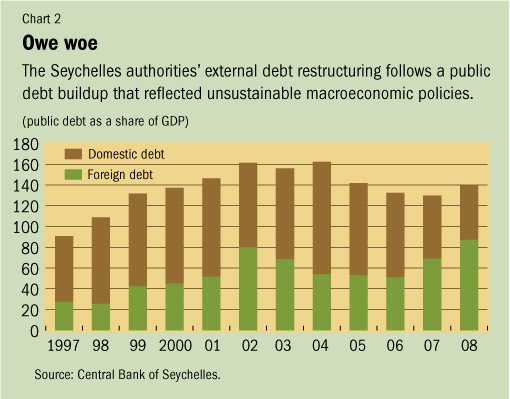SMALL ISLAND ECONOMIES

Typical street scene in Santa Ana, El Salvador. (Photo: iStock)
IMF Survey: Reforms, IMF Support Pull Seychelles Back From the Brink
June 30, 2009
- Unsustainable economic policies came to a head in mid-2008
- Exchange liberalization, fiscal reforms, tight monetary policy stabilized economy
- Focus to shift to structural measures to set economy on sustainable growth path
Less than a year after experiencing economic crisis and introducing bold economic reforms, Seychelles is seeing the fruits of its efforts.

Beach at La Digue, Seychelles: among risks beyond control of government are impact of increased Indian Ocean piracy on tourism (photo: Newscom)
A historic liberalization of its exchange regime and bold fiscal measures, together with tight monetary policy, have stabilized the economy.
Following its float, the rupee stabilized at a level about 50 percent lower against the US dollar and in spring 2009 appreciated significantly (see Chart 1). Interest rates, which went up sharply with the new market-based monetary policy, have begun easing from their peaks, and disinflation is firmly entrenched. The focus is now shifting to structural measures needed to set the economy on a sustainable growth path.
Seeds of crisis
In mid-2008, Seychelles, a tourism-based economy in the Indian Ocean, was pushed over the financial brink on which it had teetered for many years, due to the spike in commodity prices. From the late 1970s Seychelles had followed a socialist-oriented development strategy, which raised living standards but eroded the work ethic and led to large fiscal deficits. Government revenue was constrained by tax concessions to foreign investors in the growing tourism sector. The government instead borrowed on international capital markets to finance sustained spending.

From 2003 through 2007 the authorities pursued various reform efforts. However, the pace of reform was too gradual to address the magnitude of the macroeconomic imbalances. In an effort to maintain the exchange rate peg, pervasive foreign exchange restrictions were introduced with discretionary tax exemptions to compensate foreign investors for the increasingly overvalued Seychelles rupee.
An active parallel market emerged and foreign exchange shortages became endemic. Official reserves fell to very low levels and arrears on debt to official bilateral creditors began to accumulate.
In 2007–08, the petroleum and food price shock hit Seychelles particularly hard and inflation shot up. The crisis came to a head in mid-2008 when the authorities missed payments on their private foreign debt and Standard & Poor’s downgraded Seychelles to selective default.
Liberalization strategy
The authorities contacted the IMF in late June 2008 calling for discussions in support of a public debt restructuring request to the Paris Club of official creditors. Discussions in July and September focused on a coherent set of policy reforms to restore external balance and attract the support of the international community.

In early November 2008 all exchange restrictions were abolished and the currency floated. Fiscal policy was tightened, including through a major reduction in government staff, and introduction of a targeted social safety net. Interest rates were freed and a basic monetary policy introduced. The 2009 budget removed virtually all indirect product subsidies and broadened the tax base. IMF support in the form of a heavily frontloaded two-year $26 million Stand-By Arrangement was approved in mid-November.
Seychelles President James Michel recently remarked ”We requested support from the IMF to help solve these imbalances and safeguard the development goals we had achieved. This support was quickly granted. The Stand-By Arrangement is for us an example of how the instruments that govern the global economy can be adapted to meet the needs of a smaller partner.”
The authorities launched a public external debt restructuring initiative in late 2008 to put public debt on a sustainable path, by significantly reducing debt service obligations over the long term to levels consistent with the country’s limited payment capacity (see Chart 2).
In mid-April 2009, Paris Club creditors granted exceptional debt treatment to Seychelles under the 2003 Evian approach to debt relief, reducing the debt stock by 45 percent in nominal terms in two tranches, with the remainder rescheduled over 18 years with 5 years’ grace. Comparable treatment from other creditors is needed to close financing gaps over the medium term and secure public debt sustainability.
Way forward
With the rapid progress on macroeconomic stabilization, focus now shifts to structural reforms needed to set the economy on a sustainable growth path. A sustained medium-term reform effort is needed to make Seychelles more resistant to the risks it faces as a small island economy.
There are two overriding objectives ahead. A fundamental reform of the tax system is needed, to level the playing field and remove distortions and inefficiencies. The 2010 budget will introduce a broader and flatter business tax, and a personal income tax. A value-added tax will be introduced by 2012. Secondly, a major reinforcement of control over the parastatal sector is needed to address weaknesses which, if left unaddressed, could put at risk the hard-won recent gains in macrostabilization and public finances.
Comments on this article should be sent to imfsurvey@imf.org







